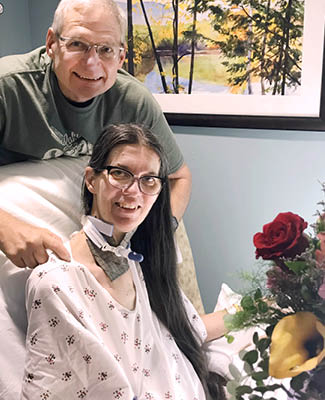Recent Posts
To sip a cola: Patsy Weber's goal for rehab from rare disease

Patsy Weber's condition had healthcare professionals at her local clinic and a regional medical center stumped. In June 2021, she went from being so healthy that she had only taken a handful of sick days during her 40 years working at a bank in Sheldon, Iowa, to not being able to get out of bed.
For about two weeks, Patsy had been coping with mysterious symptoms that included morning headaches that would disappear by the time she arrived at work and exhaustion that had her dragging throughout the day.
A week of uncertainty
On a morning in early June 2021, she told her husband, Doug, she didn't think she could get up. But the couple managed to make it to the local clinic, where her symptoms perplexed the staff. Patsy went home, only to feel worse by morning. Back at the clinic, the staff checked her blood oxygen level, which had fallen to 68.
Admitted to the hospital that day, Patsy's condition worsened. She was intubated and transported by helicopter to the medical center in Sioux Falls, South Dakota. The healthcare team suspected she might have Guillain-Barre syndrome, a rare disorder in which the body's immune system attacks the nerves. They removed a nerve sample from her ankle and a muscle sample from her arm and sent them for analysis to the medical center at the University of Iowa in Iowa City.
At one point, the healthcare team thought she was improving enough to have her breathing tube removed; three hours later, it was reinserted. After nine days in the ICU in Sioux Falls, Patsy's team was considering moving her to a care center in Lincoln, Nebraska. That's when Patsy wrote Doug a note on her tablet: "I want to go to Mayo Clinic."
Seeking answers at Mayo Clinic
On July 2, 2021, Patsy was transported to Minnesota by plane and admitted to Mayo Clinic in Rochester. Within a day, the eight specialists assigned to Patsy's care had identified her mysterious condition: nemaline myopathy. This genetic, neurological disease causes muscle weakness and reduces reflexes throughout the body, including those responsible for movement, breathing and swallowing. There is no cure; treatment includes exercise, therapy, and respiratory and feeding support.
"This was only the 20th case my neurologist had seen at Mayo," Patsy says.
One of the first steps in her care was to give her a tracheostomy to help with breathing. She also had a feeding tube inserted. Patsy was transported to Saint Marys Campus, Rochester, where she was put under the care of the pulmonologists in the respiratory care unit.
Once she was able to get off the ventilator helping her breathe, Linda Yin, M.D., an ear, nose and throat (ENT) specialist, tried to provide her with a speaking valve for her tracheostomy so she could communicate with those around her. When Patsy had a hard time forming a voice, a scope exam by Dr. Yin found that Patsy's vocal cords also were paralyzed. Dr. Yin and her colleague, Semirra Bayan, M.D., treated the paralysis with Restylane injections to help with speaking and swallowing. Despite the treatment, Patsy still couldn't talk; that would be another step.
Another thing that her healthcare team found: both of Patsy's eardrums were punctured, which was why she kept writing to Doug that she couldn't hear. The ENT team treated the injury so that she wouldn't develop an infection.
Once she was more stable, Patsy was ready to enter a rehabilitation facility to help her try to regain the functions she had lost. The facility best suited to her needs was Mayo Post Acute Care at Mayo Clinic Health System in Osseo, Wisconsin.
But Patsy was still seriously ill. Her healthcare team in Rochester was frank with her: she might never eat, walk or talk on her own again. She also might spend the rest of her life in a care facility.
Her sister, Missy Gruis, is a home healthcare nurse. When she visited Patsy and Doug in Rochester, she gave her sister a piece of advice that Patsy took to heart: "Do whatever they tell you. If you don't, you'll never go home."
Regaining her life in Osseo
"Osseo was the best option because I needed to be on a respirator," Patsy says. "I wasn't happy about it because it was so far away from my home and family. But it's the best thing that ever happened to me."
When she arrived in Osseo, Patsy was transferred to the care of pulmonologist Mark Lindsay, M.D. That's also where Patsy and Doug met her "super support team." Over the next two months, respiratory therapists David Beck-Leisz and Jesse Myers; speech therapists Amy Hilbert and Briana Kenyon; and the nurses and staff would help her gain strength, wean off the respirator and relearn how to speak and swallow.
At first, Patsy was on a ventilator 24/7. The goal was to wean her off it for at least part of the day. Because her disease affects the strength of the muscles that help her breathe, she wasn't getting enough oxygen at night and carbon dioxide would build up in her body. That's what had been causing the morning headaches that led to her diagnosis.
Patsy's respiratory and physical therapists worked to strengthen her chest muscles. Once she had more strength, she only needed the ventilator at night to ensure she was taking deep breaths while asleep.

The tracheostomy is permanent because the muscles around her trachea and throat also are weak. But with the speaking valve, she can talk. That's where the speech therapists came in, training her how to use it so she can carry on a conversation.
"We trained every day in Osseo," Doug says. "Eventually, the team had me doing everything — managing the ventilator and even the feeding tube — so I could handle it when we got home."
One of Patsy's biggest milestones was relearning how to swallow — and passing a swallow test.
She traveled to Eau Claire, Wisconsin, with Jesse and Doug for the test. "I hadn't even had an ice chip in my mouth for two months. I was terrified," Patsy says. "But Jesse told me he wouldn't let me choke and was right there if I needed suctioning.
"That's what I needed to hear — and I passed," she says. When asked what she wanted to eat or drink with her newfound ability, there was no question: an ice-cold cola.
Noting how happy it made her, Jesse called ahead to the rehabilitation center and asked them to stock some of her preferred brand, and it was waiting for her when she returned. One of her other therapists knew she liked iced coffee and would bring her one when she came to work.
"I can't say enough about the care I received from the therapists and Dr. Lindsay. Some of the nurses would take their breaks and come sit with me," Patsy says. "It's like I have a whole new family."
That caring support extended to helping Patsy through the death of her mother, which happened two weeks before Patsy was discharged. They arranged for her to watch the service online and comforted her in her loss. "A day doesn't go by that we don't think of them," Patsy says.
Rehab rock stars
Throughout all her transfers across four states, Doug was with her. He had retired in January 2021, and once she fell ill, he stayed by her side. Since Osseo was a nearly six-hour drive from their home, he settled into a nearby motel with the help of Mayo Clinic Health System staff.
"Patsy and Doug are rock stars," says Dr. Lindsay. "Osseo was the perfect fit for her, and she really knocked her recovery out of the park. She was very determined, but she was also very fortunate to have such a good partner in Doug."
Not many patients can go home on a ventilator, but because of Doug, Patsy could since she has the support she needs.
Dr. Lindsay also commends hospitalist Olawale Onibile, M.D., and the entire rehabilitation team in Osseo for how well they meet the needs of their patients.
"The strength of our program is our transitional care team," he says. "Our experienced nursing and therapy teams know how to care for patients with complex needs. Their communication, collaboration and attention to patient safety create a healing environment so patients can reach their highest level of independence. It also helped lower Patsy's stress and ensured that she and Doug felt confident to manage her care at home."
Learning more about a rare disease
Throughout her journey, Patsy and Doug learned more about nemaline myopathy, including that the muscle weakness it causes may have been a factor in the scoliosis she had dealt with all her life. The nerve and muscle samples tested in Iowa City revealed that she was born with the disorder and that one of her parents had carried the gene. Although the Webers don't have children, Patsy has alerted her siblings and their children about the need for them to consider genetic testing.
"Every test will lead to more knowledge about this disease," she says.
Two years after her health crisis, Patsy says, "They gave me my life back. I don't breathe like I did before, but I can live like this. I can go out with friends, have coffee, garden and enjoy my hobbies.
"Mayo Clinic and the rehabilitation center were a major part of my life. Of course it was scary, but they treated me like a whole person, watching out not just for my physical issues but also for my mental well-being. Their care doesn't compare to anything else."






